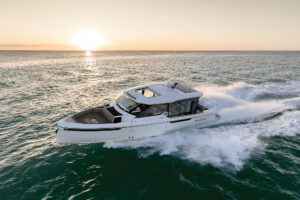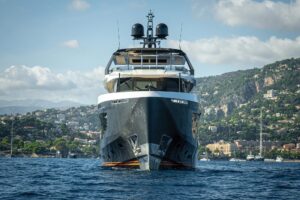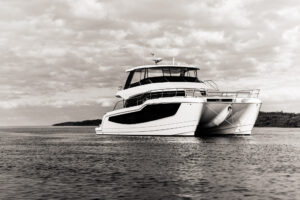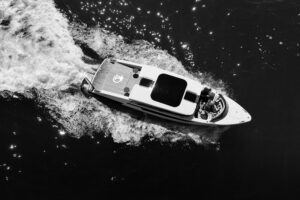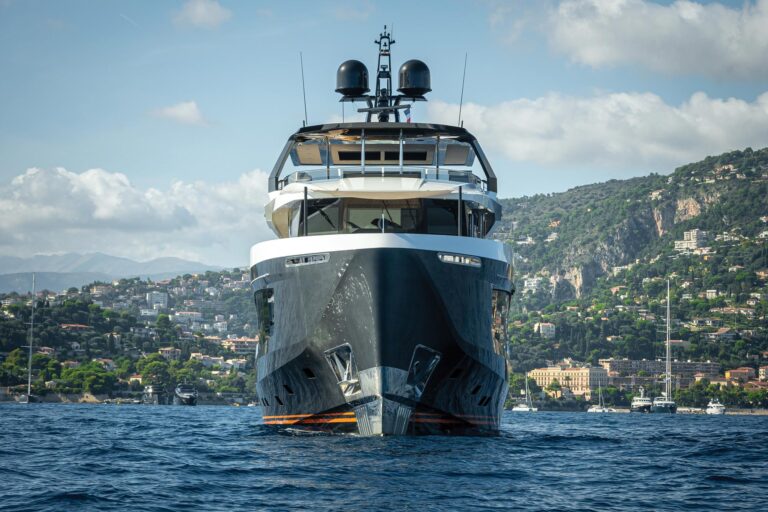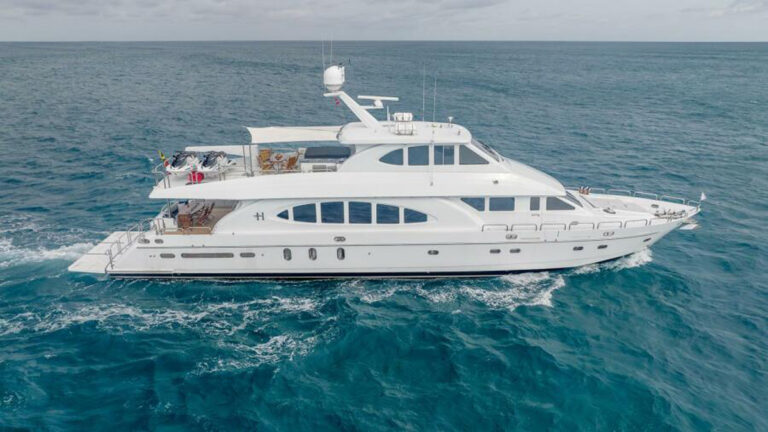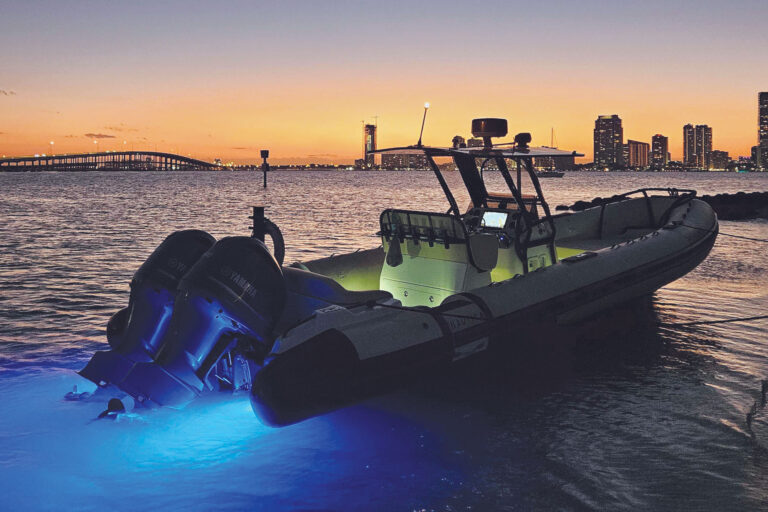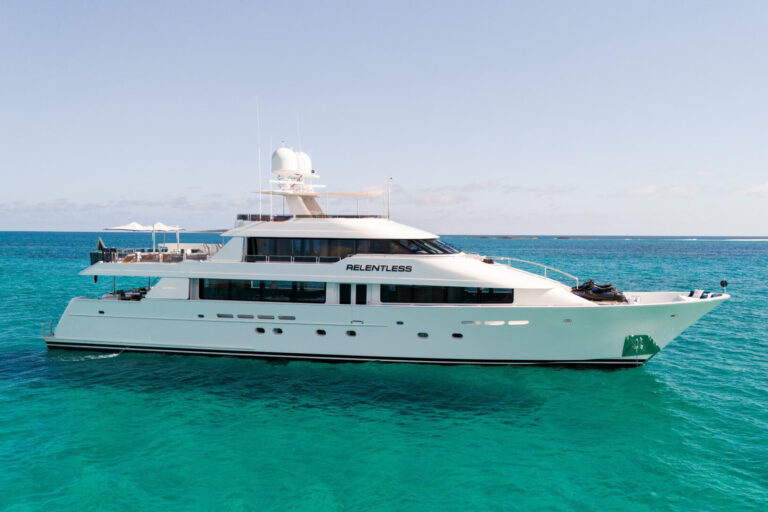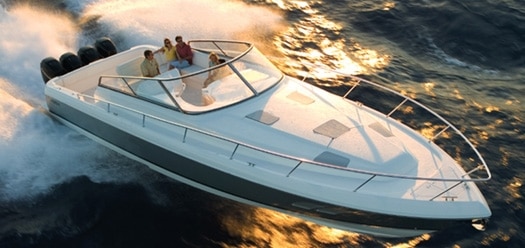
intrepid-475
Intrepid is a company that has never followed the mainstream. When “any color hull as long as it was white” was right, Intrepid offered a rainbow palette of Imron and powder-coated pipe work. When most open-console boats were built with decks cleared for hard-core angling, Intrepid offered outdoor lounges, transom seats and hull-side dive doors. Now this creative builder has turned a muscular 47-footer with four outboard engines into a yacht-and it’s brilliant.
“Yacht” wasn’t my first choice of words, at least before testing the 475. My first thought was that she would have more go-fast DNA than her sisters in the Intrepid line, after noting her power specs: four six-cylinder 275 hp Mercury Verados. And I wondered if perhaps this time Intrepid had stepped a bit too far outside of the envelope in its commitment to outboard power. But after a few minutes at the wheel, it was clear to me that John Michel, Intrepid’s creative force and owner, was spot-on, riding squarely atop the crest of outboard technology that has surged in recent years.
Technology is what allows the 475 to harness four outboards. Thanks to the Verado’s electronic control system one does not have to fiddle with four throttles; instead, engines are grouped to deliver their horsepower in perfect harmony (port and starboard), with only two throttles. The benefits of configuring four engines as two cannot be overstated. You don’t need a throttle man to tweak the 475’s performance at speed, nor will you feel ham-handed when you maneuver her in and out of tight spots dockside.
I collected our sea-trial data in a light chop on the St. Lucie River in Stuart, Fla. The 475 accelerates quickly to a maximum speed of 44.3 knots (6000 rpm). At 4500 rpm I recorded a speed of 31.4 knots and the engine electronics indicated a fuel burn of 52 gallons per hour. Her power steering delivers immediate and precise response and she can cut a turn in less than half the length of an average inboard-powered boat in her class. While she is relatively light and fast for her length, she had a solid feel as we ran through steep 4- to 5-footers in St. Lucie Inlet. Swinging her around offshore, I felt the Verados transmitted enough horsepower into the water to easily lift us above the following seas as we ran home into a stiff outgoing current. As she is a big boat turning relatively small high-speed props, the bowthruster is useful dockside.
While I tip my hat to the Mercury Verados, the 475’s excellent performance is in large part due to her hull design. Intrepid has been a pioneer in the art of sculpting stepped hulls. With a bit of science and a lot of practice, Intrepid seems to have zeroed in on the sweet spot in each of its designs in terms of efficiency and comfort at sea. The key to a stepped hull is the proper positioning of the steps and proper step ventilation. The company has long favored single transverse step configurations. Multistepped bottoms can sometimes be too trim-sensitive for pleasure-craft applications. The 475 features Intrepid’s second-generation step design-the same used for the 350 Intrepid I sea-trialed last year. As was the case with the 350, mum’s the word on specific design details other than to say the 475’s forward sections are fine and that she has a deadrise of approximately 21 degrees at the transom. Michel admits that he fiddles quite a bit with a hull’s form before committing it to production; clearly, he has an eye for what works.
Our test boat was built for Stuart, Fla., resident Todd Resnick who will use her to cruise Florida and the Bahamas with his young family. Resnick moved up from a 34-foot diesel-powered inboard and was looking for a well-built boat with more accommodations, less draft and less complication. Outboard power seemed the solution, but finding a boat large enough for his family was a challenge. “I wanted as much boat as I could manage comfortably,” says Resnick.
He discovered the 475 at a show and was impressed with the boat and its builder. “I’m a perfectionist; I don’t like to compromise on anything and that is the way John Michel approaches boat building,” says Resnick, whose primary requirement in a boat is safety. “Intrepid builds a strong, fast boat, and while I like to cruise in the mid-twenty knot range, I’m glad to know I’ve got the power and speed if I need it.” At 25 knots the 475 is planing efficiently and her fuel burn should be about 40 gallons per hour based on our sea-trial data.
The 475 is the largest boat Intrepid has built to date, and while all of this builder’s products are well above average in terms of design and finish, she is the first in my opinion that will be measured as a high-performance yacht. Her clean crisp profile follows the family line and is complemented by a rakish aluminum arch and a fiberglass hardtop. She is rife with the sorts of clever details that fans of the marque have come to expect. Aggressively styled hull-side windows are coated with a textured film that allows them to blend cleanly with the hull. Her walk-around side deck makes a trip to the bow comfortable and her hidden transom-side boarding gate makes it possible to board side-to or from a boatlift without hurtling over the coaming. The 475 is built in a new 30,000-square-foot production building at Intrepid’s facility in Largo, Fla. Stitched fiberglass and Kevlar reinforcements are laminated with vinylester resin, and high-density PVC coring is used in her bottom, hull sides and decks. Vacuum bagging is used to ensure proper bonding.
Intrepid’s creative solutions to challenges in design are often inspired by customer input. Boats on the “line” are referred to by customer name, not a number, and while there is a long list of options available, Intrepid is not close-minded when it comes to adding more. It is not uncommon for special requests to become standard options in Intrepid’s semi-custom approach to boat building.
Resnick’s boat has a hull-side dive door, transom bench seating and a 12kW diesel generator in a sound shield under the cockpit. The raised bridge has a seating area, a table and a small wet bar with an icemaker. The bridge area is air-conditioned and can be enclosed with isinglass. Cleverly integrated vents in the helm console discharge a cool blast aimed at a powder-coated aluminum helm seat that can be adjusted with a push of a button. Another push of a button lifts a section of the deck and allows access to a cavernous storage area where there is space for dive gear, fishing tackle and more.
The 475’s interior layout is ideal for cruising couples or families like the Resnicks. The main cabin has an open galley with a cook-top, a microwave-convection oven and dual-voltage refrigeration. A dual-access head has a separate shower. Yet another push of a button converts the forward seating area to a queen-size berth. The mid-ship master also has a queen-size berth; both areas are illuminated naturally by the 475’s hull-side windows. The interior is built using flawlessly tooled molded liners that add strength and stiffness to the structure. The satin-finished cherry cabinetwork and quality soft goods, hardware and fixtures add appropriate accents.
If you think outboard power is out of place on a 47-foot yacht, you need to take a ride on the 475. And if you are as impressed with her as Todd Resnick is, you will need to be patient, as there is currently a backlog of orders. In my view, the 475 is well worth the wait.
Contact: Intrepid Powerboats, (954) 922-7544; www.intrepidboats.com

